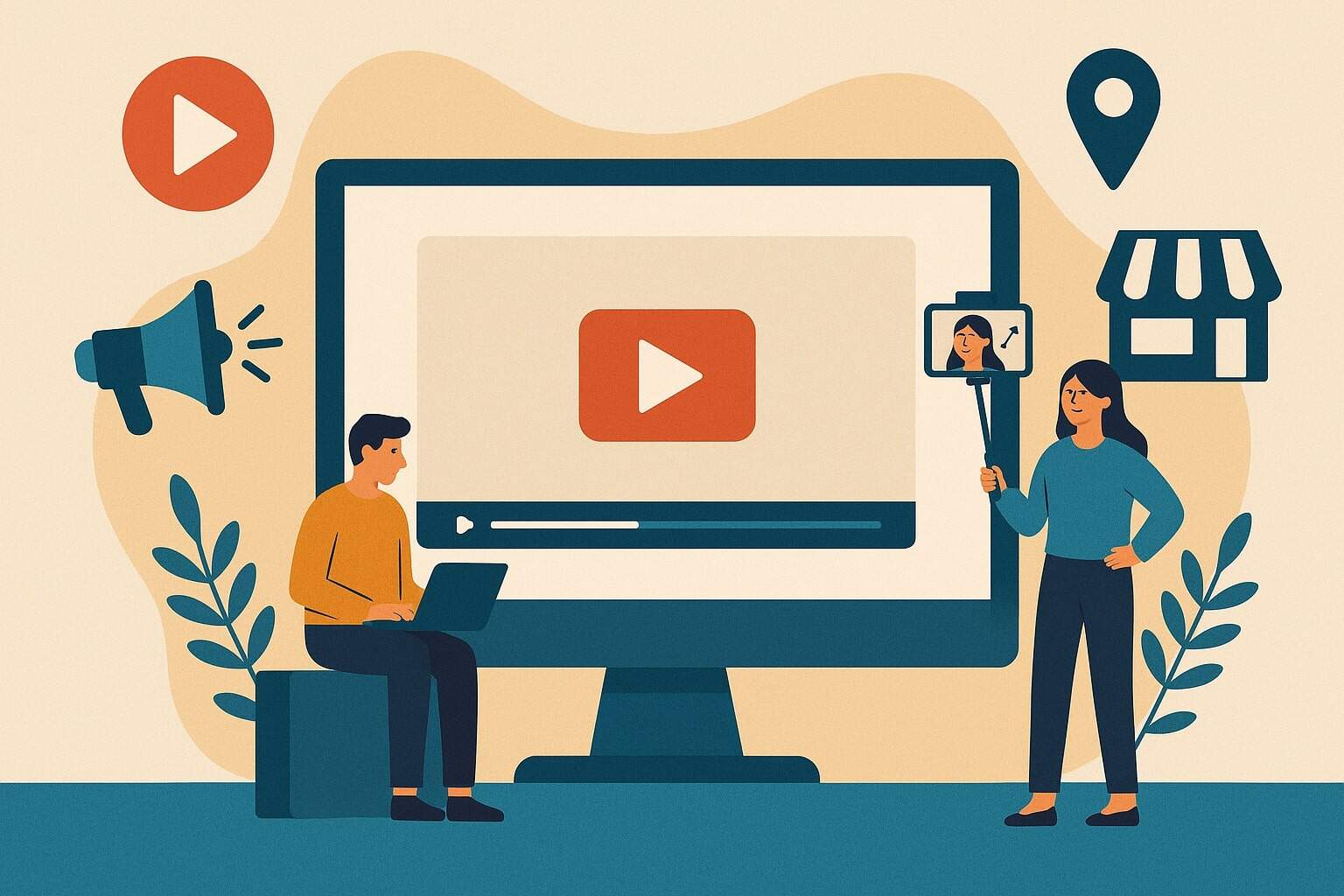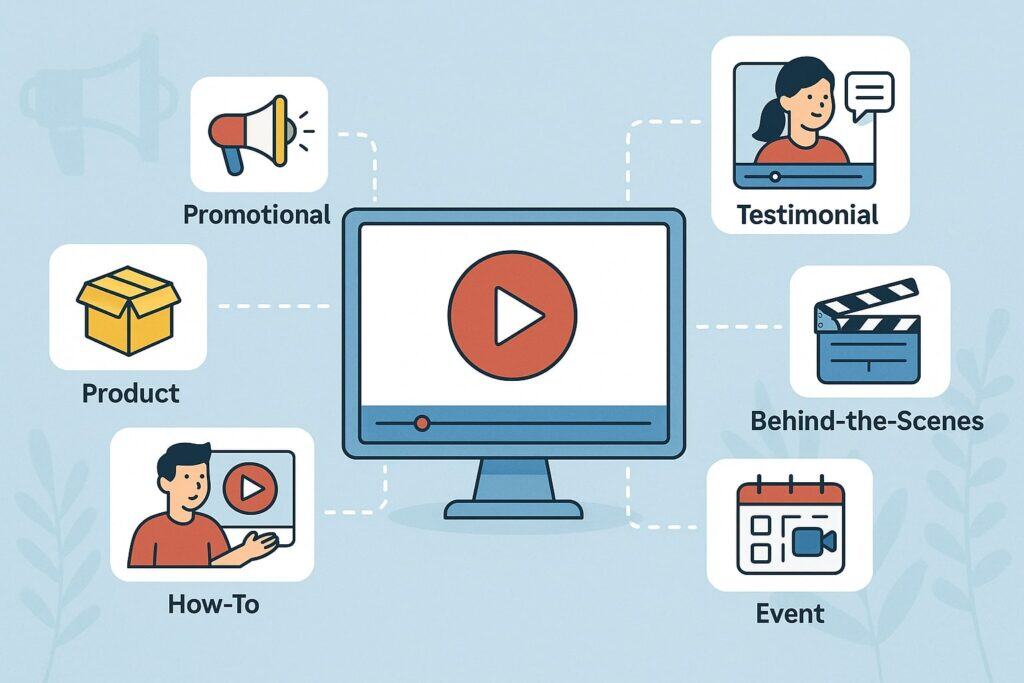
How to Use Video Marketing for Local Businesses
In today’s digital age, video marketing has emerged as one of the most powerful tools for local businesses to attract, engage, and retain customers. Consumers increasingly prefer visual content over text, and videos have proven to be more engaging, shareable, and persuasive than traditional advertising methods.
For small and local businesses, video marketing levels the playing field, offering affordable yet highly impactful ways to reach a community-based audience and build stronger connections.
Unlike large corporations with national campaigns, local businesses thrive on community trust and personal relationships. Video marketing perfectly complements this by allowing business owners to showcase their personalities, demonstrate authenticity, and highlight real customer experiences.
Whether it’s a short behind-the-scenes clip, a Facebook Live Q&A, or a well-produced promotional video, local businesses can use video to stand out in a crowded digital marketplace.
Additionally, video marketing influences buying decisions. Studies show that over 70% of consumers say they are more likely to purchase a product or service after watching a video about it.
For local businesses, this can translate into increased foot traffic, higher conversion rates, and stronger brand loyalty. Videos also enhance SEO (search engine optimization), improving the likelihood of showing up in local search results, which is vital for attracting nearby customers.
This guide will walk you through the strategies, platforms, and best practices for using video marketing effectively for local businesses. From planning and production to distribution and measuring results, you will learn everything you need to get started and maximize the benefits of this powerful medium.
Why Video Marketing Matters for Local Businesses

Local businesses often compete with larger corporations and national brands that have bigger budgets, stronger brand recognition, and more extensive marketing teams.
However, video marketing gives small and local businesses an edge by allowing them to tell their unique stories, connect personally with audiences, and foster community-based loyalty that bigger companies often lack.
Video works because it engages multiple senses—sight and sound—creating a more immersive experience than text or static images. This immersive quality allows businesses to communicate emotion, trust, and authenticity far more effectively.
For example, a local coffee shop might create a short video showcasing how they source beans from sustainable farms, how the baristas craft each cup, and how customers enjoy the cozy atmosphere. This not only promotes products but also builds a narrative around values, community, and experience.
Another reason video marketing is crucial is its impact on online visibility. Platforms like Google and social media algorithms heavily favor video content.
For instance, a local bakery posting videos of cake-decorating tutorials or customer testimonials will have a better chance of appearing in search results and feeds than a text-only post. More visibility leads to more clicks, more shares, and eventually, more customers.
Video also drives engagement across multiple platforms. Short-form videos work well on TikTok and Instagram Reels, while long-form videos can thrive on YouTube and Facebook. Live streaming builds real-time interaction and community engagement.
With smartphones making video creation easier than ever, even businesses with limited resources can consistently produce quality content that resonates with their target audience.
Ultimately, video marketing matters because it humanizes a business. Local businesses succeed by creating relationships, and video offers the most direct way to showcase passion, authenticity, and commitment. Customers no longer just buy a product; they buy into the story and values of the business.
Types of Videos Local Businesses Can Create

When it comes to video marketing, one of the most common misconceptions is that it requires a professional film crew, a big budget, or Hollywood-level production.
While high-quality visuals and sound are important, the truth is that content and authenticity matter more than perfection, especially for local businesses. Audiences appreciate genuine stories, and often, smartphone-shot videos can perform just as well as studio-produced ones when executed thoughtfully.
Here are some effective types of videos local businesses can create:
1. Promotional Videos
These highlight a business’s core offerings, such as a new product, a special discount, or an event. For example, a local gym might create a short video showcasing new equipment or a seasonal membership deal.
2. Behind-the-Scenes Videos
These give viewers an authentic look at how a business operates. A restaurant could film the kitchen preparing meals, or a florist could showcase the process of arranging bouquets. This humanizes the business and builds trust.
3. Customer Testimonials
Word-of-mouth marketing remains powerful, and video testimonials amplify it. Recording real customers sharing their positive experiences provides social proof and encourages new customers to trust the business.
4. How-To and Tutorial Videos
Educational content builds authority and positions a business as an expert in its field. A hardware store might create tutorials on DIY projects, while a salon could share hair care tips.
5. Live Videos
Platforms like Facebook Live and Instagram Live allow businesses to connect directly with customers in real time. This could include Q&A sessions, product launches, or live coverage of events.
6. Event Coverage
Local businesses can record highlights of community events, fundraisers, or seasonal promotions. This demonstrates involvement in the community and encourages people to participate.
7. Social Media Short-Form Clips
Quick, attention-grabbing videos on platforms like TikTok, Instagram Reels, and YouTube Shorts are excellent for reaching younger audiences and creating shareable content.
By mixing different types of videos, local businesses can keep their content strategy fresh and engaging. The variety also ensures that businesses appeal to different segments of their audience, from those who want quick entertainment to those who prefer detailed educational content.
Platforms for Video Marketing

Selecting the right platform for video marketing is essential for maximizing reach and engagement. Different platforms cater to different demographics, content formats, and user behaviors. For local businesses, the best approach often involves using a mix of platforms, depending on where their target customers spend time.
YouTube
As the world’s second-largest search engine, YouTube is essential for long-form content, tutorials, and promotional videos. It’s also highly searchable, meaning videos can continue generating views long after they’re posted.
With strong community engagement and support for both short and long-form videos, Facebook is ideal for local businesses looking to reach nearby customers. Facebook Live can also help build real-time engagement.
Instagram is perfect for visual storytelling through Reels, Stories, and IGTV. Short, creative videos showcasing products or behind-the-scenes content perform especially well.
TikTok
For businesses targeting younger audiences, TikTok offers massive reach potential. Local businesses can join trends, use popular audio clips, and create quick, engaging content.
While not the first platform that comes to mind for local businesses, LinkedIn works well for B2B-oriented businesses, such as consultants, law firms, or financial services. Thought leadership videos and professional updates thrive here.
Google Business Profile (GBP)
Uploading videos directly to your Google Business Profile helps attract local search traffic. For instance, a video showing the interior of a store or a customer testimonial can boost trust and encourage visits.
Choosing platforms should depend on customer demographics, business goals, and the type of content being produced. Local businesses should experiment and track engagement metrics to determine where their efforts yield the best return.
Creating an Effective Video Marketing Strategy
Video marketing is most successful when approached with a clear plan rather than random uploads. An effective strategy ensures that videos align with overall business goals, reach the right audience, and drive measurable results.
1. Define Objectives
Start by clarifying what you want to achieve with video marketing. Is it to increase brand awareness, drive foot traffic, promote a new product, or strengthen customer relationships? Having specific objectives helps shape the type of videos you create.
2. Understand Your Audience
Knowing your audience’s preferences, pain points, and online behavior ensures your videos resonate with them. For local businesses, this might involve focusing on community values or highlighting neighborhood events.
3. Plan Content Themes
Develop recurring themes to keep your content consistent. For instance, a pet grooming shop could post weekly “pet care tip” videos alongside monthly customer testimonial features.
4. Invest in Basic Equipment
You don’t need a Hollywood setup, but good lighting, clear audio, and steady visuals make a big difference. Affordable ring lights, microphones, and tripods can significantly improve video quality.
5. Optimize for SEO and Social Media
Use relevant keywords, hashtags, and geotags to improve visibility. Add captions for accessibility, and make sure thumbnails are eye-catching.
6. Schedule Consistently
Consistency builds trust. Posting videos at regular intervals ensures that your business remains visible and top-of-mind for customers.
7. Track and Analyze Results
Measure engagement, view count, click-through rates, and conversions. Use this data to refine your strategy and identify what type of content resonates most.
By following these steps, local businesses can create a strategy that is not only creative but also data-driven, ensuring long-term success.
Best Practices for Local Business Video Marketing
Creating effective videos requires more than just hitting the record button. To maximize impact, local businesses should follow best practices that make their content professional, engaging, and persuasive.
- Keep It Short and Engaging – Attention spans are short, so keep most videos under 2 minutes unless the content is educational.
- Tell a Story – People connect with stories more than sales pitches. Focus on narratives about your business, customers, or community.
- Show Authenticity – Don’t try to be overly polished. Customers value genuine personalities and real experiences.
- Highlight the Local Aspect – Showcase your involvement in the community, local events, and partnerships. This strengthens the bond with your audience.
- Include Clear CTAs – Whether it’s visiting your store, signing up for a newsletter, or following on social media, every video should guide viewers toward a next step.
- Repurpose Content – Turn long videos into short clips for multiple platforms. This maximizes your efforts and extends your reach.
- Leverage User-Generated Content – Encourage customers to share videos of themselves using your products or services. This adds authenticity and trust.
Following these best practices ensures that your video marketing not only reaches people but also motivates them to take action.
Measuring Success in Video Marketing
Creating videos is only half the battle. To ensure that your efforts are paying off, local businesses need to measure the success of their campaigns.
Key performance indicators (KPIs) include:
- View Count: How many people watched your video.
- Engagement: Likes, shares, and comments show how much your content resonates.
- Watch Time: The average time viewers spend watching your video. Longer watch times signal better engagement.
- Click-Through Rate (CTR): How many viewers took action after watching, such as clicking a link.
- Conversion Rate: The number of people who became paying customers after watching your video.
- Return on Investment (ROI): The revenue generated compared to the cost of producing and promoting the video.
By tracking these metrics, businesses can refine their strategies, invest more in successful types of content, and identify areas that need improvement.
FAQs
Q1. Do I need expensive equipment to start video marketing?
Answer: Not at all. Many successful local businesses use nothing more than a smartphone to record their videos. What matters most is clear audio, good lighting, and authentic content. You can enhance quality with affordable accessories such as tripods, ring lights, and external microphones.
While professional equipment and editing software can improve production value, they are not required to get started. Customers care more about the story and authenticity than whether your video looks like a high-budget advertisement.
If your business grows and you want to scale your video marketing, investing in better equipment or hiring freelancers for editing can be considered.
However, starting small allows you to test what works without risking large amounts of money. The goal is to begin creating and sharing content consistently rather than waiting for the “perfect” setup.
Q2. How often should a local business post videos?
Answer: Consistency is key in video marketing. For most local businesses, posting one to three videos per week is an ideal rhythm. This frequency keeps your business visible without overwhelming your audience or overextending your resources. The important part is to maintain a schedule that you can realistically stick to.
For example, if you own a small boutique, you might post a weekly behind-the-scenes video on Facebook, a short product showcase on Instagram Reels twice a week, and a monthly tutorial video on YouTube.
The mix keeps your content fresh while ensuring your audience knows when to expect new content. Over time, analyze engagement metrics to determine which frequency and platforms drive the best results.
Q3. What types of videos generate the most engagement for local businesses?
Answer: Customer testimonials, behind-the-scenes content, and educational how-to videos tend to perform best for local businesses. These formats build trust, humanize your brand, and provide value to your audience.
For instance, a landscaping company sharing before-and-after transformation videos will generate more engagement than simply posting static images of their work.
Additionally, short-form videos (under 60 seconds) on TikTok, Instagram Reels, and YouTube Shorts have become highly effective due to their viral potential.
These platforms reward creativity and relatability, making them excellent for local businesses to showcase personality and authenticity. Testing different video formats helps you identify what resonates most with your audience.
Q4. How can local businesses promote their videos effectively?
Answer: Promotion is just as important as production. Uploading videos and waiting for people to find them is not enough. Share your videos across multiple platforms, embed them on your website, and include them in email newsletters. Encourage customers to share your videos by offering small incentives or running contests.
Paid advertising can also be highly effective for local businesses. Platforms like Facebook and YouTube allow you to target audiences based on location, interests, and demographics.
This ensures your videos reach potential customers who are most likely to convert. Combining organic reach with paid promotions creates a balanced and effective distribution strategy.
Q5. How do I know if my video marketing is working?
Answer: Success in video marketing is measured by engagement and conversions, not just views. High view counts are encouraging, but if viewers aren’t liking, commenting, or taking the next step (such as visiting your website or making a purchase), your strategy may need adjusting. Look closely at watch time, click-through rates, and conversion rates to gauge effectiveness.
For example, if you notice that most viewers drop off after the first 15 seconds, your introductions may need to be more engaging. If your videos generate lots of engagement but few conversions, it might be time to refine your calls to action. Continually tracking and analyzing these metrics helps refine your approach and ensures long-term growth.
Conclusion
Video marketing has transformed the way local businesses can connect with their customers. It offers an affordable, highly engaging, and versatile way to promote products, build trust, and foster loyalty.
By creating authentic and valuable content, leveraging the right platforms, and consistently analyzing results, local businesses can use video to compete with larger brands while strengthening community connections.
The beauty of video marketing lies in its flexibility. Whether you’re a restaurant sharing behind-the-scenes clips, a gym showcasing success stories, or a boutique creating style tutorials, there’s no limit to the creative ways video can help your business grow.
Start small, remain authentic, and focus on delivering value, and over time, video marketing can become one of the most powerful tools in your local business growth strategy.